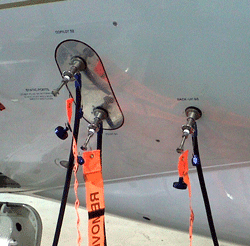Contributed by Jeff King, Chief Inspector - Components/Satellites

Duncan Aviation technicians hook up the RVSM test-set to the right-side static ports to test the copilot's RVSM system.
Though nearly every general aviation aircraft has received RVSM certification, maintaining that certification has become a cloudy process for operators. With the new Height Monitoring Requirements now a reality, operators continue to have questions. Here is a recent question from a Directory Maintenance about long-term RVSM monitoring.
What if my aircraft has the factory RVSM STC, do I still have to have the flight check every two years?
The answer is yes. No matter how the RVSM solution was installed on your aircraft, you are still required to meet the Height Monitoring requirement.
The guidance says every two years or 1000 flight hours, whichever is greatest. So if you fly less than the 1,000 hours in the two year period, you can continue to meet the height monitoring requirement until you reach the 1,000 hour limit.
Meeting Height Monitoring Requirements
Height Monitoring Requirements are easily met if your aircraft is equipped with Mode S transponders. With Mode C transponders you will need to have a qualified technician come on board and perform the monitoring.
For more information, read the regulatory Requirements for RVSM Maintenance Intelligence article, or download the Straight Talk About RVSM booklet.
Jeff King is the Chief Inspector of Duncan Aviation's Component Solutions and Avionics Satellite Network. He specializes in FAA regulatory compliance for repair stations and aircraft maintenance professionals. His aviation career began in 1987.


